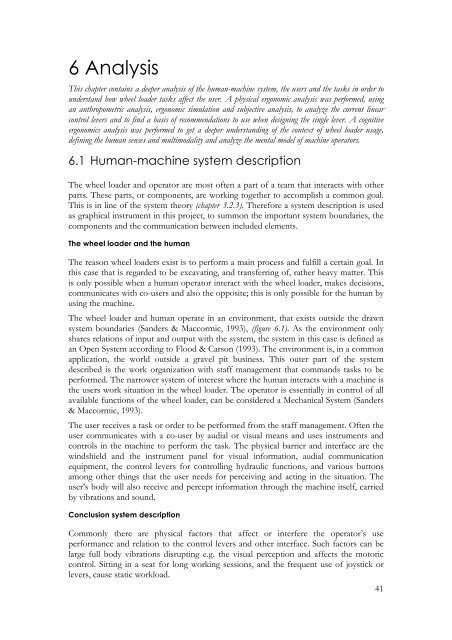Design of an ergonomic control lever for wheel loader attachments
Design of an ergonomic control lever for wheel loader attachments
Design of an ergonomic control lever for wheel loader attachments
Create successful ePaper yourself
Turn your PDF publications into a flip-book with our unique Google optimized e-Paper software.
6 Analysis<br />
This chapter contains a deeper <strong>an</strong>alysis <strong>of</strong> the hum<strong>an</strong>-machine system, the users <strong>an</strong>d the tasks in order to<br />
underst<strong>an</strong>d how <strong>wheel</strong> <strong>loader</strong> tasks affect the user. A physical <strong>ergonomic</strong> <strong>an</strong>alysis was per<strong>for</strong>med, using<br />
<strong>an</strong> <strong>an</strong>thropometric <strong>an</strong>alysis, <strong>ergonomic</strong> simulation <strong>an</strong>d subjective <strong>an</strong>alysis, to <strong>an</strong>alyze the current linear<br />
<strong>control</strong> <strong>lever</strong>s <strong>an</strong>d to find a basis <strong>of</strong> recommendations to use when designing the single <strong>lever</strong>. A cognitive<br />
<strong>ergonomic</strong>s <strong>an</strong>alysis was per<strong>for</strong>med to get a deeper underst<strong>an</strong>ding <strong>of</strong> the context <strong>of</strong> <strong>wheel</strong> <strong>loader</strong> usage,<br />
defining the hum<strong>an</strong> senses <strong>an</strong>d multimodality <strong>an</strong>d <strong>an</strong>alyze the mental model <strong>of</strong> machine operators.<br />
6.1 Hum<strong>an</strong>-machine system description<br />
The <strong>wheel</strong> <strong>loader</strong> <strong>an</strong>d operator are most <strong>of</strong>ten a part <strong>of</strong> a team that interacts with other<br />
parts. These parts, or components, are working together to accomplish a common goal.<br />
This is in line <strong>of</strong> the system theory (chapter 3.2.3). There<strong>for</strong>e a system description is used<br />
as graphical instrument in this project, to summon the import<strong>an</strong>t system boundaries, the<br />
components <strong>an</strong>d the communication between included elements.<br />
The <strong>wheel</strong> <strong>loader</strong> <strong>an</strong>d the hum<strong>an</strong><br />
The reason <strong>wheel</strong> <strong>loader</strong>s exist is to per<strong>for</strong>m a main process <strong>an</strong>d fulfill a certain goal. In<br />
this case that is regarded to be excavating, <strong>an</strong>d tr<strong>an</strong>sferring <strong>of</strong>, rather heavy matter. This<br />
is only possible when a hum<strong>an</strong> operator interact with the <strong>wheel</strong> <strong>loader</strong>, makes decisions,<br />
communicates with co-users <strong>an</strong>d also the opposite; this is only possible <strong>for</strong> the hum<strong>an</strong> by<br />
using the machine.<br />
The <strong>wheel</strong> <strong>loader</strong> <strong>an</strong>d hum<strong>an</strong> operate in <strong>an</strong> environment, that exists outside the drawn<br />
system boundaries (S<strong>an</strong>ders & Maccormic, 1993), (figure 6.1). As the environment only<br />
shares relations <strong>of</strong> input <strong>an</strong>d output with the system, the system in this case is defined as<br />
<strong>an</strong> Open System according to Flood & Carson (1993). The environment is, in a common<br />
application, the world outside a gravel pit business. This outer part <strong>of</strong> the system<br />
described is the work org<strong>an</strong>ization with staff m<strong>an</strong>agement that comm<strong>an</strong>ds tasks to be<br />
per<strong>for</strong>med. The narrower system <strong>of</strong> interest where the hum<strong>an</strong> interacts with a machine is<br />
the users work situation in the <strong>wheel</strong> <strong>loader</strong>. The operator is essentially in <strong>control</strong> <strong>of</strong> all<br />
available functions <strong>of</strong> the <strong>wheel</strong> <strong>loader</strong>, c<strong>an</strong> be considered a Mech<strong>an</strong>ical System (S<strong>an</strong>ders<br />
& Maccormic, 1993).<br />
The user receives a task or order to be per<strong>for</strong>med from the staff m<strong>an</strong>agement. Often the<br />
user communicates with a co-user by audial or visual me<strong>an</strong>s <strong>an</strong>d uses instruments <strong>an</strong>d<br />
<strong>control</strong>s in the machine to per<strong>for</strong>m the task. The physical barrier <strong>an</strong>d interface are the<br />
windshield <strong>an</strong>d the instrument p<strong>an</strong>el <strong>for</strong> visual in<strong>for</strong>mation, audial communication<br />
equipment, the <strong>control</strong> <strong>lever</strong>s <strong>for</strong> <strong>control</strong>ling hydraulic functions, <strong>an</strong>d various buttons<br />
among other things that the user needs <strong>for</strong> perceiving <strong>an</strong>d acting in the situation. The<br />
user’s body will also receive <strong>an</strong>d percept in<strong>for</strong>mation through the machine itself, carried<br />
by vibrations <strong>an</strong>d sound.<br />
Conclusion system description<br />
Commonly there are physical factors that affect or interfere the operator’s use<br />
per<strong>for</strong>m<strong>an</strong>ce <strong>an</strong>d relation to the <strong>control</strong> <strong>lever</strong>s <strong>an</strong>d other interface. Such factors c<strong>an</strong> be<br />
large full body vibrations disrupting e.g. the visual perception <strong>an</strong>d affects the motoric<br />
<strong>control</strong>. Sitting in a seat <strong>for</strong> long working sessions, <strong>an</strong>d the frequent use <strong>of</strong> joystick or<br />
<strong>lever</strong>s, cause static workload.<br />
41
















